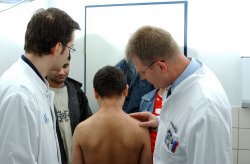Treatment of ichthyoses

Although for the vast majority (80%) of ichthyoses the underlying molecular defect is today known, a targeted and causative therapy is not yet possible. The treatment approach takes into account the individual disease features and the severity of the disease and therapy is symptom relieving.
As the skin is dry, it is necessary to provide water and lipids and to carry out measures for mechanical scale removal. Intensive bathing is very useful. Bathing serves to make the skin clean, to remove remnants of creams, scales and bacteria from the skin surface. Many bathing additives are possible. In our experience bicarbonate (baking powder) works very well. The application of sponges or microfiber gloves allows to remove scales efficiently once the skin is soaped. Bicarbonate in the bathing water facilitates this mechanical scale removal.
Many affected patients also benefit from frequent stays in a steam sauna. It may be worth to install into your own home a steam sauna if your child finds this agreeable and benefits from it.
Ointments for ichthyosis therapy consist out of a so called “vehicle” which contains oils, lipids and water in varying degrees. Examples for vehicles are petrolatum, eucerin etc. It is possible to incorporate into these vehicles active substances that promote desquamation. These are e.g. glycerol, urea, salt, lactic acid and to some extent vitamin A acid which, however, can be irritating. Also the vehicle component polyethlenglycol (macrogol) has a desquamative effect.
The most widely used substance in Germany is urea. However, it is not meaningful to use urea in the first year of life because of the side effects and a tremendous absorption. In this time period dexpanthenol is a good alternative.
In small children salicylic acid is better avoided or used with utmost care if at all on small areas of the body only due to poisoning when larger body parts are treated. This can even happen when low concentrations are used. The strongest desquamative effect is seen with vitamin A acid, but its applications can easily cause severe skin irritations and a stinging of the skin limiting its use considerably. Some substances can be combined to achieve a better overall result.Below we give concentrations in general use for these desquamative substances
- Vitamin A acid 0.025%
- Glycerol up to 15%
- Urea up to 12%
- Salt (NaCl) up to 5%
- Lactic acid up to 5%
- Polyethylenglycol, charge 300 to 400, up to 20%
In general the dosage used has to be adapted to each individual and also the body site treated has to be considered. Treatment needs to be individualized! Individual tolerance, for example for urea concentration vary greatly and differ also in small children.
A systemic therapy with the drug Neotigason® (substance: acitretin) is possible. This drug is a retinoid and related to vitamin A. It also has many side effects including teratogenicity. A comprehensive review of retinoid therapy and of topical therapy approach is beyond the scope of this text.
We want to point out that the NIRK network together with the German patient organization Selbsthilfe Ichthyose e.V. has established a therapy guideline that has been recognized by the working group of the scientific societies (AWMF) in Germany, the official head organization of all scientific medical associations.
For affected persons or for families it is very helpful to become a member of the patient organization in their respective country. These associations can also help when questions arise concerning financial support by the state government and affected persons benefit greatly from practical exchange of experience.
